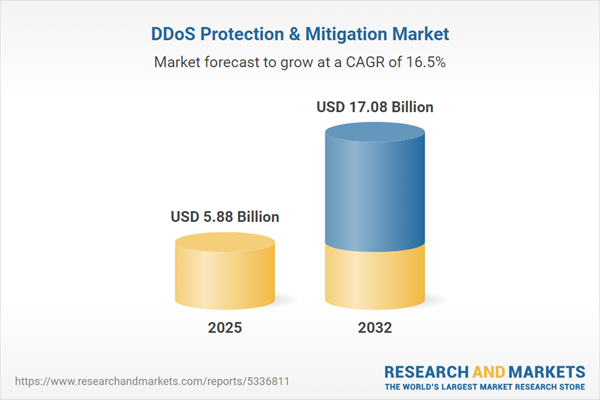Speak directly to the analyst to clarify any post sales queries you may have.
The DDoS Protection & Mitigation Market is rapidly evolving as organizations prioritize advanced cybersecurity solutions to safeguard business operations and meet emerging compliance obligations in a complex digital environment.
Market Snapshot: DDoS Protection & Mitigation Market Overview
The global DDoS protection and mitigation market is experiencing robust growth, driven by the increasing frequency and sophistication of cyber threats targeting mission-critical infrastructure in both public and private sectors. As digital transformation advances in industries such as finance, healthcare, energy, retail, and telecommunications, organizations increasingly seek secure, resilient infrastructure to ensure business continuity and maintain operational efficiency. The adoption of cloud and edge technologies in security platforms supports ongoing operational needs and compliance with dynamic regulatory frameworks. Growing digital complexity and ever-tightening regulatory demands are compelling organizations to implement strategic, adaptive defenses to manage risk across interconnected ecosystems.
Scope & Segmentation: Strategic Relevance for Leaders
This market empowers decision-makers through clear segmentation and solution options designed to align with evolving security and compliance requirements:
- Component: Managed services, professional support, hardware appliances, and software solutions collectively strengthen prevention capacity, maintain compliance, and support continuous improvement in security environments.
- Deployment Mode: Cloud-based, hybrid, public, private, and on-premise deployments facilitate operational flexibility, enabling organizations to design solutions that address internal priorities and seamlessly adapt to regional regulatory differences.
- Organization Size: Scalable offerings allow both large enterprises and SMBs to enhance their defenses as digital infrastructures expand and risk profiles evolve.
- Security Type: Multi-layer protections, such as application-level and network-level security, are designed to address the full spectrum of DDoS threats, allowing organizations to anticipate and neutralize both common and evolving attack techniques.
- End User: Decision-makers in banking, defense, energy, government, healthcare, information technology, public sector, retail, telecommunications, and utilities are leading adopters, applying industry-specific insights to protect their unique vulnerabilities.
- Regional Coverage: The Americas, Europe, Middle East & Africa, and Asia-Pacific each contribute distinct adoption trends, shaped by local regulatory landscapes and differing enterprise needs, making regional strategy critical for competitive differentiation.
- Featured Companies: Major industry providers such as Cloudflare, Akamai Technologies, Amazon Web Services, Alibaba Cloud, Radware, F5, Cisco Systems, Huawei Technologies, Netscout Systems, and Imperva deliver compliance-ready, adaptive solutions, ensuring sector-wide standards and robust risk management frameworks.
Key Takeaways: Strategic Insights for Senior Decision-Makers
- Comprehensive DDoS protection frameworks integrate seamlessly into core continuity strategies, reducing network and application vulnerability amid growing threat sophistication.
- Adoption of automation, artificial intelligence, and advanced analytics sharpens threat detection and streamlines incident response, bolstering resilience in organizations with intricate operational ecosystems.
- Flexible security deployment options enable organizations to adapt with agility to evolving compliance mandates and emerging threat vectors across geographies.
- Continuous monitoring and proactive management across IT and IoT workflows reduce risk, minimize system downtime, and preserve stakeholder trust.
- Managed detection and rapid response coordination offer operational agility, empowering organizations to mitigate risks effectively, even during periods of heightened attack volume or crisis scenarios.
- Development in adaptive defense and analytics tools is helping providers address emerging regulatory expectations, which strengthens their overall industry standing and competitiveness.
Tariff Impact: U.S. Tariffs and Global Supply Chain Considerations
Recent tariff changes in the United States have increased hardware costs related to DDoS mitigation, placing renewed pressure on international supply chains. In response, organizations are diversifying supplier networks and focusing on software-driven security architectures to preserve operational stability and compliance consistency within fluctuating trade and regulatory environments. This strategic adaptation supports standardized security postures and reinforces risk mitigation practices as international policy landscapes shift.
Methodology & Data Sources
This overview is based on market input from chief information security officers, leading analysts, and tier-one vendors, alongside current regulatory review and sector-specific research. Results have been validated by scenario modeling to deliver relevant, practical intelligence tailored for executive leadership and strategic planning.
DDoS Protection & Mitigation Market: Why This Report Matters
- Provides senior leaders with targeted, actionable insight to guide investment in security solutions as both cyber threat and compliance environments evolve worldwide.
- Clarifies procurement pathways and compliant segmentation, facilitating effective decisions that preserve enterprise value and ensure organizational resilience.
- Enables infrastructure executives to proactively anticipate and address new operational and cybersecurity risks through forward-looking intelligence.
Conclusion
DDoS mitigation is essential for maintaining digital business operations. Strategic planning and executive engagement ensure resilient, adaptive protection in an era of evolving threats and regulatory requirements.
Additional Product Information:
- Purchase of this report includes 1 year online access with quarterly updates.
- This report can be updated on request. Please contact our Customer Experience team using the Ask a Question widget on our website.
Table of Contents
3. Executive Summary
4. Market Overview
7. Cumulative Impact of Artificial Intelligence 2025
Companies Mentioned
The companies profiled in this DDoS Protection & Mitigation market report include:- Cloudflare, Inc.
- Akamai Technologies, Inc.
- Amazon Web Services, Inc.
- Alibaba Cloud (Beijing) Software Technology Co., Ltd.
- Radware Ltd.
- F5, Inc.
- Cisco Systems, Inc.
- Huawei Technologies Co., Ltd.
- Netscout Systems, Inc.
- Imperva, Inc.
Table Information
| Report Attribute | Details |
|---|---|
| No. of Pages | 192 |
| Published | November 2025 |
| Forecast Period | 2025 - 2032 |
| Estimated Market Value ( USD | $ 5.88 Billion |
| Forecasted Market Value ( USD | $ 17.08 Billion |
| Compound Annual Growth Rate | 16.4% |
| Regions Covered | Global |
| No. of Companies Mentioned | 11 |









